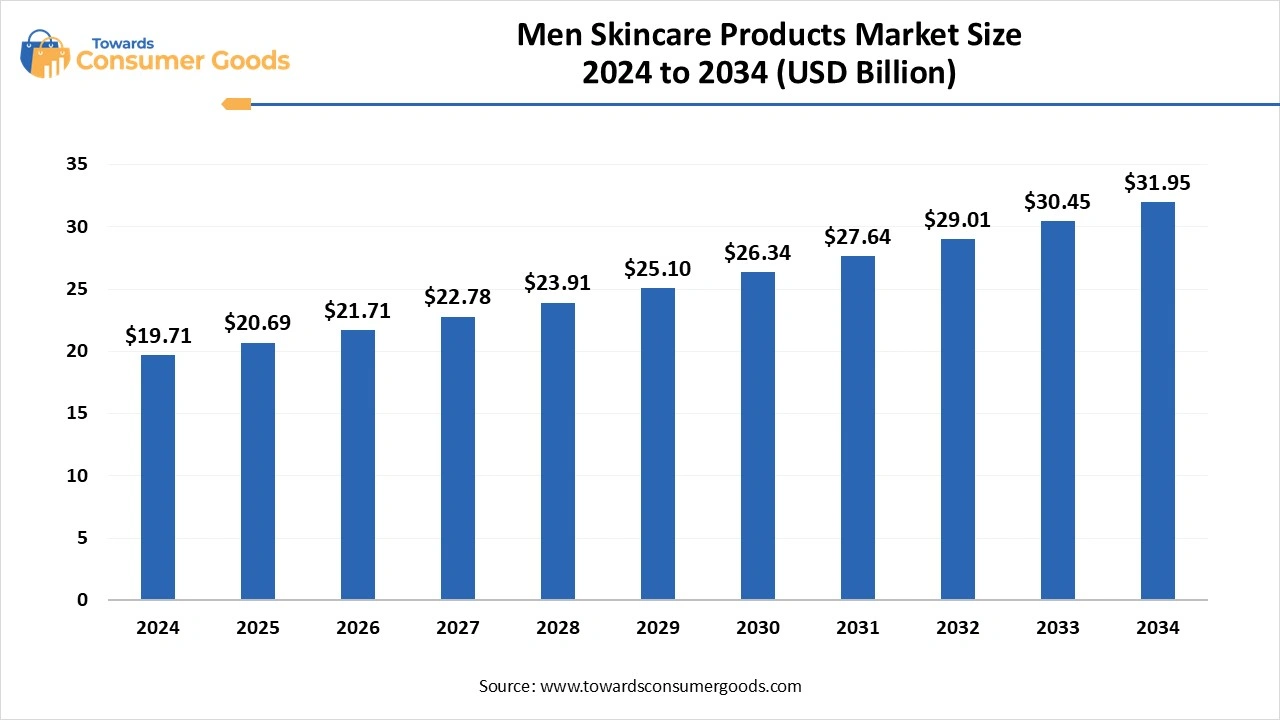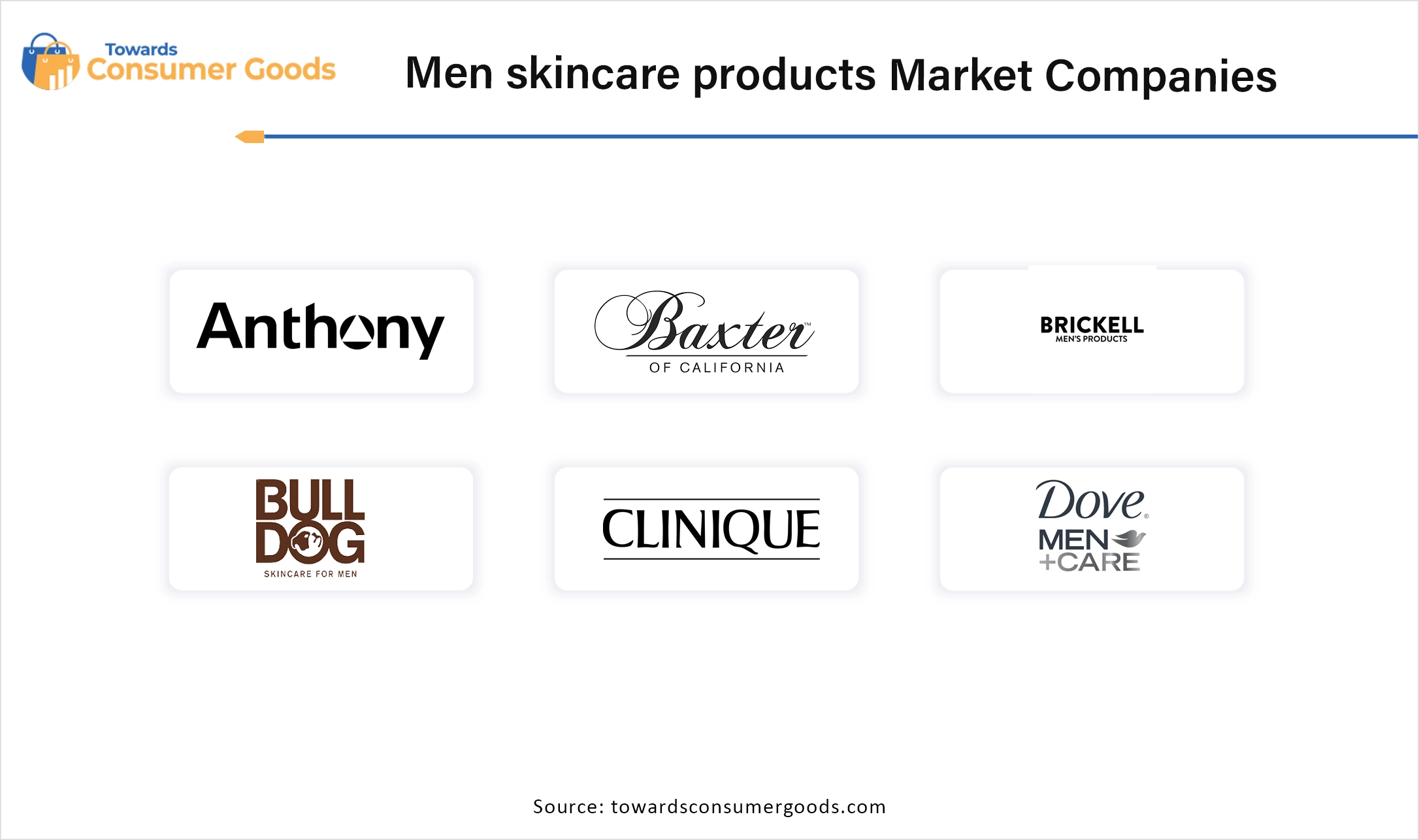April 2025
The global men skincare products market size was valued at USD 19.71 billion in 2024 and is estimated to hit around USD 31.95 billion by 2034, growing at a compound annual growth rate (CAGR) of 4.95% during the forecast period 2025 to 2034.The increased in awareness about men’s skincare and demand for natural products have driven the market growth.

The men’s skin care product market is increasingly evolving, fueled by shifting societal norms that emphasize the importance of personal grooming. There is a growing awareness among men regarding the necessity for products designed specifically for their unique skin care needs. Men's skin generally exhibits distinct characteristics, such as thicker dermis, higher oil production, and variations in skin density compared to women's skin. As a result, many brands are developing formulations that specifically target these differences, leading to a surge in tailored solutions. For instance, men frequently seek out pre-moisturizing oils or specialized products aimed at managing beard growth, which can significantly affect skin health.
Common skin concerns among men, such as acne breakouts, razor bumps, sensitivity, sun damage, and the visible signs of aging, are driving the creation of targeted products. This includes a variety of offerings, such as specialized cleansers that effectively remove dirt without stripping the skin's natural oils, gentle exfoliants to slough off dead skin cells, potent serums packed with active ingredients like hyaluronic acid and vitamin C, and treatments designed to address specific issues.
For instance, multi-functional products like moisturizers infused with SPF or all-in-one face washes that cleanse, exfoliate, and hydrate are gaining popularity among men who prefer efficient regimens that yield visible results without requiring significant time investment. The changing attitude towards skin care among men is also reflected in a growing interest in maintaining healthy, youthful-looking skin. This transformation is largely driven by an increasing understanding of the benefits of skin care, coupled with a desire for self-care practices.
The stigma that previously surrounded men’s use of skin care products is dissipating, as grooming is now recognized as a key component of self-confidence and overall well-being. The influence of social media, particularly through influencers and celebrities, plays a pivotal role in reshaping men’s grooming habits, promoting the notion that skin care is not just acceptable but essential.
Online platforms have emerged as valuable resources for men seeking information about skin care trends, reviews, and product recommendations, making them more discerning consumers willing to invest in quality skin care solutions. There is a noteworthy demand for products tailored to address specific concerns, such as acne, sensitivity, signs of aging, and beard maintenance. This has paved the way for the development of specialized offerings like beard oils, anti-aging creams with advanced formulations, and targeted treatments designed for particular skin conditions.
Moreover, the market is increasingly catering to individuals with sensitive and combination skin types, reflecting a more sophisticated understanding of varying skin needs. There is a marked rise in consumer preference for natural, organic, and chemical-free products, with many shoppers now prioritizing ingredients that are cruelty-free and environmentally friendly. As convenience remains a top priority, multifunctional products that tackle multiple skin concerns in a single application, such as combined moisturizers and sunscreens, are rapidly gaining traction.
The expansion of men’s skin care products is further supported by their availability across diverse retail channels, including supermarkets, hypermarkets, convenience stores, pharmacies, and online platforms. This widespread access is not only fueling market growth but is also empowering men to take control of their skin care journeys, underscoring the increasing importance of grooming in modern masculinity.
| Report Attributes | Details |
| Market Size in 2025 | USD 20.69 Billion |
| Expected size in 2034 | USD 31.95 Billion |
| Growth Rate | CAGR of 4.95% from 2025 to 2034 |
| Base Year of Estimation | 2024 |
| Forecast Period | 2025-2034 |
| Dominant Region | North America |
| Segment Covered | By Product, By Consumer Preference, By Age Group, By Distribution Channel, By Region |
| Key Companies Profiled | Anthony Skincare,Baxter of California,Brickell Men's Products,Bulldog Skincare,Clinique for Men,Dove Men+Care,Every Man Jack,Harry's,Jack Black,Kiehl's,Lab Series,L'Oréal Men Expert,Neutrogena Men,Nivea Men |
Looking ahead to market opportunities, the future landscape of male grooming is set to transform towards a more holistic approach to self-care that encompasses all body aspects. Greater social acceptance of intimate hygiene products signals a need for brands to innovate continuously, crafting solutions that are not only effective but also effectively normalized and destigmatized in their marketing. Technological advancements are poised to significantly influence future grooming trends with the emergence of smart grooming devices on the horizon.
These innovative tools, potentially powered by AI, could adapt to individual hair thickness and growth patterns, revolutionizing the grooming experience. Furthermore, the growth of virtual skincare consultations and apps that provide personalized grooming advice will empower men to curate tailored routines that meet their particular needs and preferences.
The male grooming industry has expanded far beyond mere shaving; it now encompasses a comprehensive range of products that include beard care, skincare, and intimate hygiene. As men become increasingly invested in their self-care, brands have a unique opportunity to cater to the diverse grooming needs and desires of this demographic. By prioritizing transparency, personalization, and education, companies can play a pivotal role in shaping the future of male grooming, ultimately empowering men to feel confident and cared for in every facet of their grooming routine.
Segmental Insights
The online segment of the skin care product market has emerged as the dominant revenue contributor, primarily due to the explosive growth of e-commerce platforms. These online marketplaces provide an unmatched level of convenience, allowing men to browse and purchase skin care products at any time, all from the comfort of their homes. This ease of access is a key factor driving the popularity of online shopping for skin care. Moreover, online platforms harness advanced data analytics and sophisticated algorithms to offer personalized product recommendations tailored to individual browsing histories, purchasing behaviors, and skin preferences, which greatly enhances the overall shopping experience.
Conversely, the offline segment of the market also commands a substantial revenue share. Purchasing products in physical stores provides customers with the immediate gratification of acquiring and using skin care products on the spot, bypassing the uncertainties and waiting times associated with online orders. Additionally, in-store representatives and beauty advisors can offer personalized recommendations and address customer inquiries on the spot, which is particularly beneficial for men who may be unfamiliar with skin care routines and products.
Within the product categories, the creams and moisturizers segment has not only captured the largest revenue share but is also projected to experience the highest growth rate in the coming years. Moisturizing is universally recognized as a fundamental component of any skin care regimen, pertinent to all ages, skin types, and concerns. These products are essential for hydrating skin, effectively preventing issues such as dryness, flakiness, and discomfort. Unlike targeted treatments aimed at specific concerns, such as acne or aging, moisturizers have a broad appeal and are utilized as daily necessities by a wide demographic of men.
The luxury experience segment has achieved the highest revenue share, driven largely by consumers’ desire for premium products that offer top-tier results. Luxury skin care brands heavily invest in extensive research and development efforts, marketing high-quality ingredients, advanced formulas, and innovative technologies that attract discerning customers seeking optimal skin care outcomes. Conversely, the budget-friendly experience segment is gaining momentum and is expected to grow at the fastest rate over the forecast period. These affordable options make skin care accessible to a broader audience, including younger men and those new to skin care routines. For many, these budget options serve as an entry point into the world of skin care.
The demographic segment of men aged 19 to 35 has recorded the largest revenue share due to their upbringing in an era dominated by the Internet and social media. This group is particularly attuned to skin care trends, information, and product reviews, thanks to the vast array of content available on platforms like Instagram, TikTok, and YouTube, where influencers and dermatologists frequently share insights.
On the other hand, the 36 to 50 age bracket is set to register the highest growth rate during the forecast period. Men in this demographic are beginning to experience more pronounced signs of aging, such as wrinkles, fine lines, age spots, and reduced skin elasticity. This heightened awareness compels them to actively seek out skin care solutions specifically designed to address these age-related concerns.
In terms of regional performance, North America stands out as the leading market, accounting for the largest revenue share. The region’s consumers exhibit a strong willingness to invest in premium and innovative skin care solutions, significantly contributing to market value. North American consumers are often early adopters of new skin care technologies and ingredients. Additionally, the robust rate of e-commerce adoption in this region means that online sales serve as a major channel for acquiring skin care products. Consumers here are generally well-informed about the ingredients in their skin care products and understand the benefits of different product types, which drives demand for effective and specialized skin-care solutions.
Looking ahead, the Asia-Pacific region is anticipated to experience the highest growth rate over the forecast period. Factors such as urbanization and the shift toward Westernized lifestyles in metropolitan areas are fueling greater awareness and demand for grooming products among men. The influence of social media, coupled with endorsements from male celebrities and beauty influencers in this region, plays a significant role in normalizing and promoting skin care. Countries like South Korea and Japan are recognized as global leaders in skincare innovation and product development. The growing popularity of K-Beauty and J-Beauty routines has profoundly shaped male grooming habits across the Asia-Pacific region, leading to more men adopting detailed multi-step skin care regimens.

By Product Type
By Consumer Preference
By Age Group
By Distribution Channel
By regions
April 2025
April 2025
April 2025
April 2025